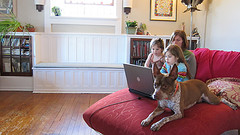As parents, the topic of Internet safety isn’t always one that’s always easy to navigate, but it’s certainly one of the most important things to integrate into our lives. For many of us, computers and the Internet aren’t things that were ever-present while growing up; at least not like they are today. These days it seems like every kid in Kindergarten knows how to access the web, and most teens have some kind of Facebook or MySpace account.
Because it’s tough to know where to start, we’ve got a few suggestions to help make the process of making the Internet a safe place to visit (at least in your home) an easier task. While this is by no means an exhaustive list, it’s a good starting point to use or modify to fit the needs of your family.
- Keep Internet-enabled computers out in the open:
Allowing a computer to be used in private isn’t necessarily a bad thing, but it’s not necessarily a good thing, either. Whether or not your kids are viewing inappropriate websites or their chat/email conversations are getting out of hand, keeping computers in an open space allows you to periodically check up on your children to make sure they’re handling the responsibility of Internet usage properly.
We suggest that you keep any computers that can access the Internet to be in plain view of everyone. Bringing a laptop to the kitchen table, setting up a desk in the living room, or anything else that will keep the screen of the computer easily visible are all good starts.
- Set times limits for casual Internet usage:
It’s a good idea to set time limits for children to be able to check their email, IM with friends, or update their Facebook pages. Time limits ensure that your kids get to have a bit of fun, but not get so wrapped up in the Internet that things like homework or family time get pushed aside.
Whether you set up limits on daily usage (e.g. no more than 2 hours per day), or whether you set up a specific block of time (e.g. between 7:00PM and 9:00PM), a schedule helps everyone understand when the appropriate time to surf the web is, and to schedule other events around it. It also ensures that you know when you’ll be able to check your Facebook page, too. 🙂
- Verify browser settings and check their history:
Setting up an appropriate browsing environment is especially important for younger children, but even teens and young adults can benefit from some added safety settings. Make sure that the security settings on your browser aren’t set too low, making it easier for malicious software (“malware”) to get onto your computer. Also make sure that the browser history is left intact so that you can periodically review where your kids have been browsing.
- Know who your kids are chatting with online:
Just like you want to know who your kids are friends with in real life, the same should go for their online friends. Who they are and what they talk about are important pieces of information for a parent to know.
More than likely their friends are other family members or kids from school, but the Internet is a big place, and not everyone is who they say they are. Things to check for should include sending photos of themselves to strangers, arranging to meet anyone they don’t know in real life, and inappropriate chat/email conversations.
- Talk to your kids about Internet safety:
Above all, make sure that you sit down and talk with your kids about Internet safety, your expectations, and what is appropriate and inappropriate for your kids and your family to view or search for online. Curiosity or accidentally clicking on a bad link are one thing, but actively searching for illicit materials or engaging in dangerous or inappropriate behaviors are another. Set firm boundaries so that there are no questions regarding what’s OK and what’s not OK.
If you have any additional tips or suggestions, or even how you’ve set up a safe Internet environment in your home, we’d love to hear from you. Just leave us a comment below and share your story.
If you're looking for great anti-virus software that won't break the bank, try StopSign. You don't pay extra for tech support for difficult malware, and our web protection software just works. Download & install StopSign to find out why our members choose us over the other options.




Recent Blog Comments